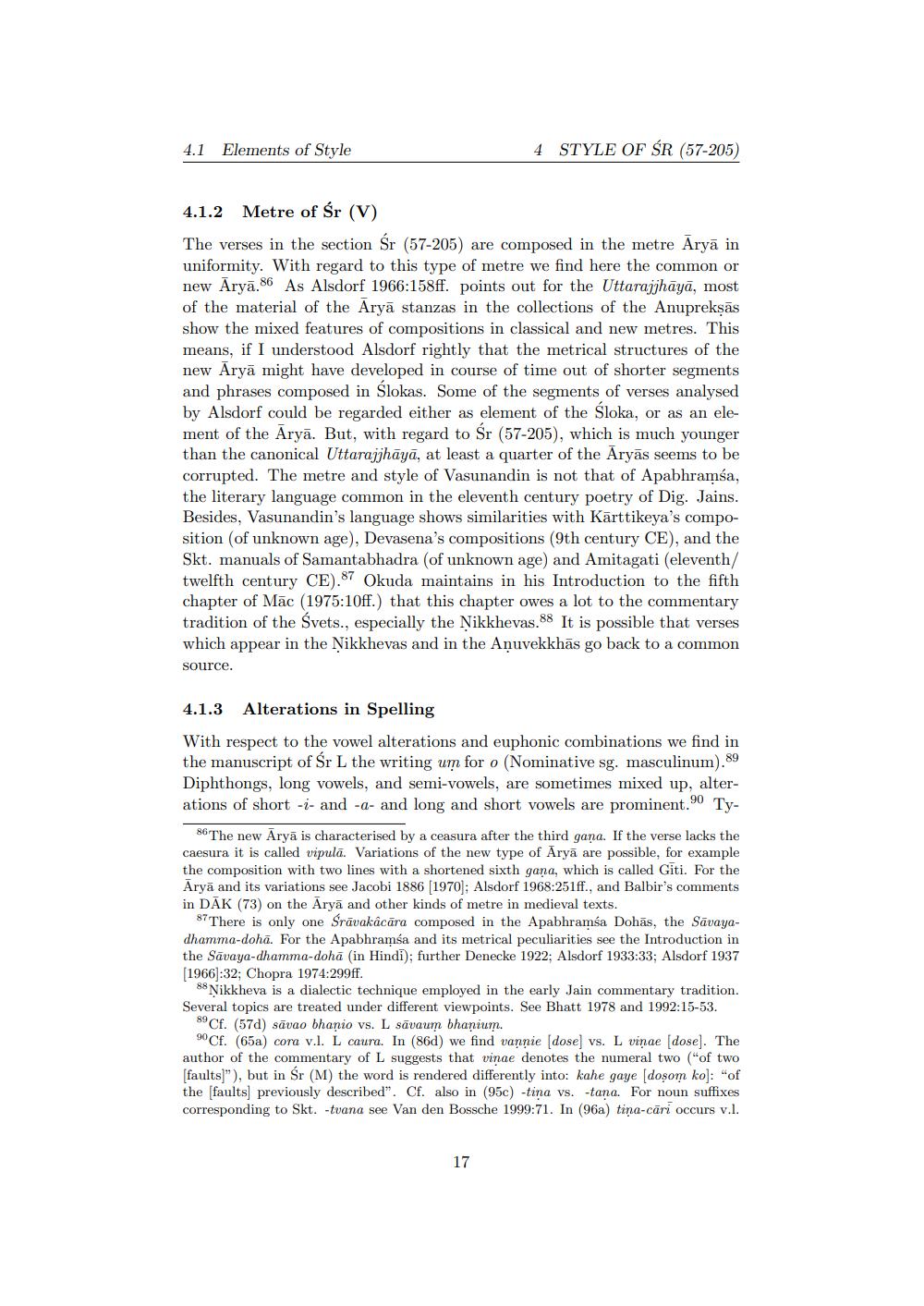________________
4.1 Elements of Style
4 STYLE OF ŚR (57-205)
4.1.2 Metre of Śr (V) The verses in the section Sr (57-205) are composed in the metre Aryā in uniformity. With regard to this type of metre we find here the common or new Aryā.86 As Alsdorf 1966:158ff. points out for the Uttarajjhāyā, most of the material of the Aryā stanzas in the collections of the Anuprekşās show the mixed features of compositions in classical and new metres. This means, if I understood Alsdorf rightly that the metrical structures of the new Aryā might have developed in course of time out of shorter segments and phrases composed in Slokas. Some of the segments of verses analysed by Alsdorf could be regarded either as element of the Sloka, or as an element of the Aryā. But, with regard to Sr (57-205), which is much younger than the canonical Uttarajjhāyā, at least a quarter of the Aryās seems to be corrupted. The metre and style of Vasunandin is not that of Apabhramsa, the literary language common in the eleventh century poetry of Dig. Jains. Besides, Vasunandin's language shows similarities with Kārttikeya's composition of unknown age), Devasena's compositions (9th century CE), and the Skt. manuals of Samantabhadra (of unknown age) and Amitagati (eleventh twelfth century CE).87 Okuda maintains in his Introduction to the fifth chapter of Māc (1975:10ff.) that this chapter owes a lot to the commentary tradition of the Svets., especially the Nikkhevas. 88 It is possible that verses which appear in the Nikkhevas and in the Aņuvekkhās go back to a common source.
4.1.3
Alterations in Spelling
With respect to the vowel alterations and euphonic combinations we find in the manuscript of Sr L the writing um for o (Nominative sg. masculinum).89 Diphthongs, long vowels, and semi-vowels, are sometimes mixed up, alterations of short -j- and -a- and long and short vowels are prominent.90 Ty
86 The new Aryā is characterised by a ceasura after the third gana. If the verse lacks the caesura it is called vipula. Variations of the new type of Aryā are possible, for example the composition with two lines with a shortened sixth gang, which is called Giti. For the Aryā and its variations see Jacobi 1886 [1970]; Alsdorf 1968:251ff., and Balbir's comments in DĀK (73) on the Aryā and other kinds of metre in medieval texts.
87 There is only one Srāvakâcāra composed in the Apabhramsa Dohās, the Sävayadhamma-doha. For the Apabhramba and its metrical peculiarities see the Introduction in the Sāvaya-dhamma-dohā (in Hindi); further Denecke 1922; Alsdorf 1933:33; Alsdorf 1937 (1966):32; Chopra 1974:299ff.
88 Ņikkheva is a dialectic technique employed in the early Jain commentary tradition. Several topics are treated under different viewpoints. See Bhatt 1978 and 1992:15-53.
*9 Cf. (57d) sāvao bhanio vs. L sāvaum bhanium.
90Cf. (65a) cora v.l. L caura. In (860) we find vannie dose) vs. L viņae dose). The author of the commentary of L suggests that vinae denotes the numeral two of two (faults]"), but in Śr (M) the word is rendered differently into: kahe gaye (dosom ko): "of the faults previously described". Cf. also in (950) -tina vs. -tana. For noun suffixes corresponding to Skt. -tuana see Van den Bossche 1999:71. In (96) tina-cāri occurs v.l.
17




